Ali Weatherford
Breastfeeding rates are measured by many hospitals, birth centers, and care providers. There are several different things they’re looking at. They want to know how many people even try to breastfeed. They want to know how many people are successfully breastfeeding when they leave the facility after giving birth. And it’s also important to follow up and see how many people are continuing to breastfeed successfully at different ages. A lot of times, the six month mark is used to compare.
Benefits of Breastfeeding
These statistics are collected for many reasons. It’s widely understood that breastmilk is important for optimal health. It’s associated with better newborn transition and better health overall. Of course, this is a general concept. Optimal means the very best possible, not that other options can’t be good. It does not mean that every breastfed baby will be perfectly healthy or that every formula fed baby will be UNhealthy. I never want a family to hear that giving a baby formula means they can not have a healthy baby! That is not true. It just means that there are general tendencies, and that getting breast milk lowers risks for certain things and may be able to provide some better health outcomes.
It can also be a benefit to families in other ways. When breastfeeding goes well, it can be the most safe and cost effective way to feed a baby, and can save time and energy on pumping, bottle washing, and formula preparation. We’ve also been able to see a lot about formula recalls and shortages in the news over the last few years.
Why People Don’t Breastfeed
If all of these things are true, then it’s really hard to understand why so many families do not breastfeed. There are so many factors here. If there was a problematic birth or NICU stay for the baby, that can make establishing a great milk supply more difficult. Some babies are not very energetic or active at first for a variety of reasons, and that can make breastfeeding harder for them. Some people don’t want to breastfeed. Others have structural issues of the breast or the baby’s mouth which can make breastfeeding more difficult.
But the reality is that for most people, difficulties with breastfeeding come from a lack of education, and not from a lack of ability or desire. People usually have some expectations about breastfeeding. They might expect it to be very easy and natural, and then are faced with something very different. Most people don’t prepare, and then when they are faced with some obstacles to easy breastfeeding, they assume that there is something wrong with themselves or their babies and decide to go a different way. This is completely understandable. It’s also avoidable.
Prenatal breastfeeding education is vital and is shown to significantly improve breastfeeding rates.
As the manager of parent education, I get to help decide the kinds of classes we offer to expectant and new parents. My goal is to provide classes that people want and need. Breastfeeding classes often take top priority at Breastfeeding Success of course because of our company mission, but also because we understand how valuable this education is for new parents. I’m very lucky to hear about the outcomes of this education directly from the bedside. We have a large staff of hospital-based lactation consultants who are working so closely with families right after they give birth. They teach and demonstrate and problem solve with families every day.
Most of the families really want to be able to provide breast milk to their babies in whichever way they can or in whichever way works best for their family. Our team is there to help them do that.
What You’ll Learn in Breastfeeding Classes
I have asked several hospital-based lactation consultants if they are able to tell whether education helps people with breastfeeding. The very clear answer is always YES. They report that it’s easy to tell which families have taken a breastfeeding class and which have not. Some things that you will learn in a good prenatal breastfeeding class include:
- Why breastfeed?
- How to get things off to a good start
- What to expect in the first few days
- What to expect during engorgement
- Milk production explained – establishing and maintaining supply
- How to know that things are going well and when to ask for hel
- Understanding and overcoming common breastfeeding challenges
- Hand expression
- Using breast pumps and other tools
The people who take a class during pregnancy usually have more realistic expectations of breastfeeding and don’t panic when things are actually just going normally. They are more relaxed and confident. They are more ready to take in information about breastfeeding positions and help with the baby’s latch because they understand that there are many ways to do this and that breastfeeding almost always goes better with some hands-on help at first. They often know to take steps during labor and delivery to ensure better breastfeeding outcomes, like asking for immediate skin-to-skin contact with their babies and asking to delay other interventions and interruptions until after they’ve been able to breastfeed successfully. They know when to ask for help from a lactation consultant.
Benefits of Prenatal Education
There is also some great research on the benefits of prenatal breastfeeding education. The published articles linked in the resources below show very clear benefits, and the research looks at the issue from a lot of different angles. What it boils down to is that it’s very reasonable to expect that taking a breastfeeding class will increase your chances of breastfeeding success! We have many options at Breastfeeding Success, but you can look into other options near you or online. Wherever you do it, you will be sure to learn something new and important, and knowledge is power
References

